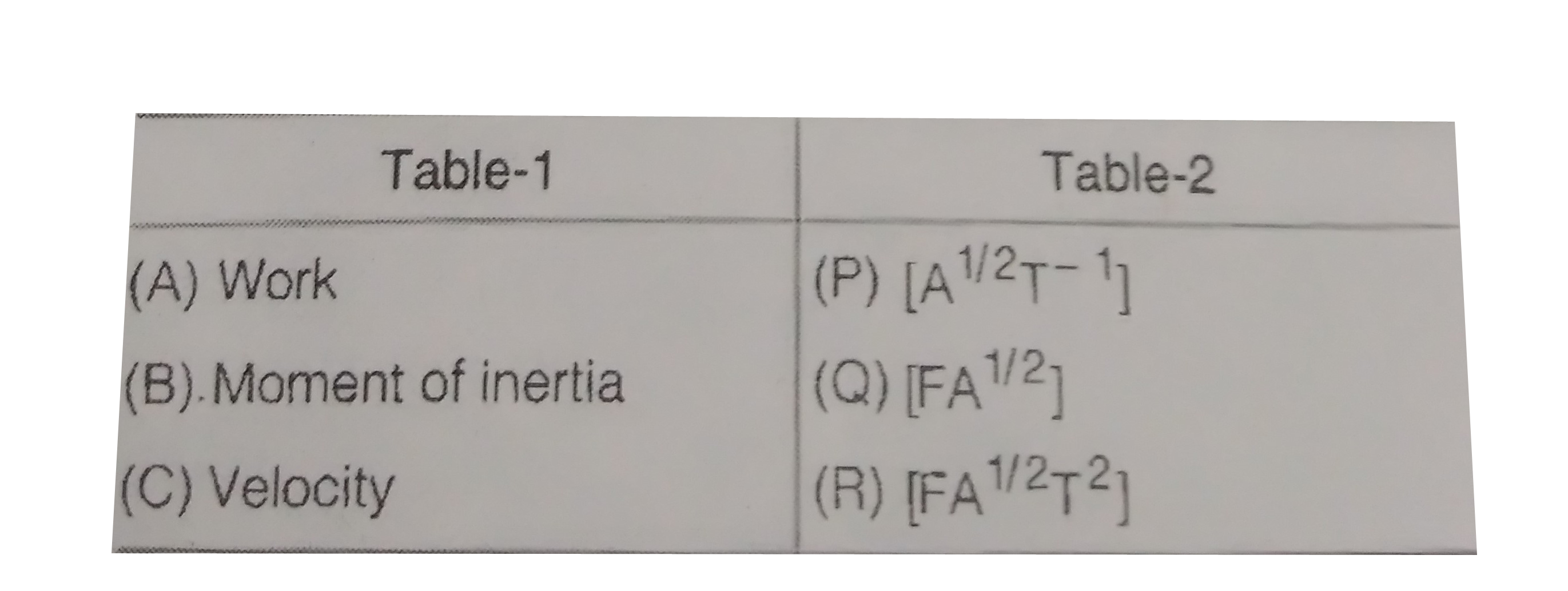If force F, area A and density D are teken as the fundamental units, the representation of Young's modulus 'Y' will be
[F−1A−1D−1]
[FA−2D2]
[FA−1D]
[FA−1D0]
The correct Answer is:D
To find the representation of Young's modulus Y when force F, area A, and density D are taken as fundamental units, we can follow these steps:
Step 1: Understand Young's Modulus
Young's modulus Y is defined as the ratio of stress to strain. Mathematically, it can be expressed as:
Y=StressStrain
Step 2: Define Stress and Strain
- Stress is defined as force per unit area:
Stress=FA
- Strain is a dimensionless quantity, defined as the change in length divided by the original length:
Strain=ΔLL
Since strain is dimensionless, it does not contribute to the dimensions of Young's modulus.
Step 3: Substitute Stress into Young's Modulus
Substituting the expression for stress into the formula for Young's modulus gives:
Y=F/AStrain=FA
Step 4: Determine the Dimensions of Force and Area
- The dimension of force F is given by:
(F)=MLT−2
where M is mass, L is length, and T is time.
- The dimension of area A is:
(A)=L2
Step 5: Calculate the Dimensions of Young's Modulus
Now substituting the dimensions of force and area into the expression for Young's modulus:
Y=(F)(A)=MLT−2L2=ML−1T−2
Step 6: Express in Terms of Fundamental Units
Since we are considering force F, area A, and density D as fundamental units, we need to express Young's modulus in terms of these units:
- The dimension of density D is:
(D)=ML3
This means that density does not contribute to the dimensions of Young's modulus since it is dimensionless in this context.
Final Representation
Thus, the representation of Young's modulus Y in terms of the fundamental units of force F, area A, and density D is:
Y=F1A−1D0
This simplifies to:
Y=F1A−1
Conclusion
Therefore, the representation of Young's modulus Y when force, area, and density are taken as fundamental units is:
Y=F1A−1D0
Young's modulus Y is defined as the ratio of stress to strain. Mathematically, it can be expressed as:
Y=StressStrain
- Stress is defined as force per unit area:
Stress=FA
- Strain is a dimensionless quantity, defined as the change in length divided by the original length:
Strain=ΔLL
Since strain is dimensionless, it does not contribute to the dimensions of Young's modulus.
Substituting the expression for stress into the formula for Young's modulus gives:
Y=F/AStrain=FA
- The dimension of force F is given by:
(F)=MLT−2
where M is mass, L is length, and T is time.
- The dimension of area A is:
(A)=L2
Now substituting the dimensions of force and area into the expression for Young's modulus:
Y=(F)(A)=MLT−2L2=ML−1T−2
Since we are considering force F, area A, and density D as fundamental units, we need to express Young's modulus in terms of these units:
- The dimension of density D is:
(D)=ML3
This means that density does not contribute to the dimensions of Young's modulus since it is dimensionless in this context.
Thus, the representation of Young's modulus Y in terms of the fundamental units of force F, area A, and density D is:
Y=F1A−1D0
This simplifies to:
Y=F1A−1
Therefore, the representation of Young's modulus Y when force, area, and density are taken as fundamental units is:
Y=F1A−1D0
Topper's Solved these Questions
- BOOK - AAKASH INSTITUTECHAPTER - UNITS AND MEASUREMENTSEXERCISE - ASSIGNMENT (SECTION - C)31videos
UNITS AND MEASUREMENTS
- BOOK - AAKASH INSTITUTECHAPTER - UNITS AND MEASUREMENTSEXERCISE - ASSIGNMENT (SECTION - D)15videos
UNITS AND MEASUREMENTS
- BOOK - AAKASH INSTITUTECHAPTER - UNITS AND MEASUREMENTSEXERCISE - ASSIGNMENT (SECTION - A)50videos
UNITS AND MEASUREMENTS
- BOOK - AAKASH INSTITUTECHAPTER - THERMODYNAMICSEXERCISE - ASSIGNMENT (SECTION -D) (Assertion - Reason Type Questions)10videos
THERMODYNAMICS
- BOOK - AAKASH INSTITUTECHAPTER - WAVE OPTICSEXERCISE - Assignment (Section-J (Aakash Challengers question))1videos
WAVE OPTICS
Similar Questions
Knowledge Check
- Question 1 - Select One
If force F, area A and density D are teken as the fundamental units, the representation of Young's modulus 'Y' will be
AF−1A−1D2BFA−2D−2CFA−1D0DFA−1D - Question 2 - Select One
The unit of Young’s modulus is
ANm2BNm−2CNmDNm−1 - Question 3 - Select One
If velocity (v), acceleration (a) and force (F) are taken as fundamental quantities, the dimensions of Young's modulus (Y) would be
A[Fa2v−2]B[Fa2v−3]C[Fa2v−4]D[Fa2v−5]
Suppose force (F) , area (A) and time (T) are the fundamental units, then match the following
 View Solution
View SolutionIf frequency F, velocity V , and density D are considered fundamental units , the dimensional formula for momentum will be
View SolutionIn MKS system, unit of Young's modulus is
View SolutionThe units of Young's modulus of elasticity are
View SolutionIf the density of the material increase, the value of young's modulus
View Solution

